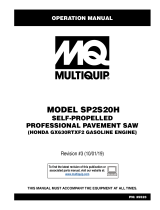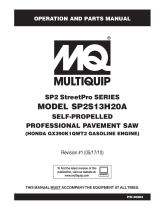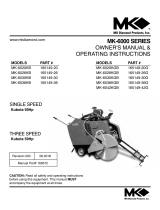Page is loading ...



CONCRETE SAW OPERATING INSTRUCTIONS
ASSEMBLY
1. Handles must be turned around and attached properly.
Place in position, set to desired height and securely tighten
knobs. Note that the handles can be placed in a tilted
position for improved leverage.
2. Remove the pre-cleaner from box and securely clamp to air
cleaner.
3. Connect the negative battery cable end to the negative
battery terminal. Tighten the cap screw and nut securely to
assure proper electrical contacts.
4. Be certain to check engine and transmission oil levels and
service before using. Refer to engine manual for detailed
information.
5. On electric saw models, the proper size power cord must be
provided by the purchaser, for wiring motor starter to power
source. Refer to chart on inside of starter box cover for
recommended wire gauge.
GENERAL INSTRUCTIONS
1. Be certain you have the correct diamond or abrasive blade.
Contact your authorized servicing dealer for the correct
specification. Getting the correct blade will make a
tremendous difference in your blade costs and performance.
2. The blade shaft flange and arbor must be inspected for
damage and cleaned before mounting the blade. If
damaged, replace bad parts. Inspect blade for damage to
arbor hole and flange area before attempting to mount blade.
3. Mount the blade solidly and firmly on the blade shaft arbor
using the wrench provided. Make sure the arrow on both the
blade and the blade guard are pointing in the same direction
of rotation. The lock pin(s) in the outer blade flange must go
completely through the blade and into the matching hole(s)
in the inside blade flange. Tighten the blade flange bolt
very securely (Approximately 77 lb.ft.). Note that the blade
shaft bolt on the right hand side has left hand threads, which
tightens by turning counter clockwise. The blade shaft bolt
on the left hand side has right hand threads, which tightened
by turning clockwise.
4. WARNING: Do not operate without proper blade guard in
place. Do not operate with front of blade guard raised.
Blade exposure cannot exceed 180 degrees when cutting.
5. The front and rear pointer must be checked for alignment
with blade. It must be in line with a blade mounted shaft.
Use a chalk line or a long straight edge to verify alignment.
6. Do not use conventional (wet) diamond blades without
water! You must have from 2-1/2 to 5 gallons of water per
minute flowing over the blade for proper cooling and to get
maximum blade life. For wet sawing, are sure the spray
holes in the blade guard tubes are open and that each side
of the blade has an adequate supply of water. Test your
water supply fro pressure and quantity (low) before starting
to saw.
7. Saw in a straight line. Mark the cutting line clearly so the
saw operator can follow the line without difficulty. The saw
should not be twisted from side to side trying to force the
blade back on line.
8. Saw only as deep as the specifications and job conditions
require. This will save blade life and reduce sawing costs.
Sawing excessively deep is wasteful and should be avoided.
TO START SAW
1. Fill the tank and check the engine oil level. Refer to the engine
manual for details.
-WARNING: Always have the hydrostatic transmission speed
control lever in the neutral position or disengage the transmission
drive system before starting the engine.
2. Place water safety switch in the OFF position
3. Start engine. Follow procedure in engine manual.
5. Let engine warm up at half throttle.
6. All sawing is done at full throttle. Governor is factory set for
correct engine speed. Do not change the governor setting unless
you are changing the blade capacity, and need to adjust the
blade shaft speed. (See chart in saw parts list for correct blade
speeds and governor settings.)
TO MANEUVER SAW
1. Raise blade as high as possible so blade will not strike
pavement when maneuvering by pressing button on left side
of speed control handle. To lower blade, simply press push
button on right side. Note that the engine need not be
running in order to raise and lower blade. Lowering speed
may be altered by adjusting flow control valve located on the
side of the hydraulic pump unit.
2. Extend handles to desired location to achieve best leverage.
Lift rear wheels just above pavement and maneuver saw as
desired.
3. To maneuver with power, engage the transmission drive, if
necessary, and move speed control lever forward or
backward from neutral position. This lever permits infinitely
variable ground speed (up to 200 feet per minute) in forward
and reverse.
-WARNING: When engaging the transmission, be sure the speed
control lever is at neutral to avoid movement of the saw. When
maneuvering with power, the engine should be running at half
throttle or more so the hydrostatic transmission can operate
efficiently. For maximum speed forward or reverse, the engine
must be running at full throttle.
TO START SAWING
1. Follow all the instructions outlined above.
2. Align blade with cut .For wet sawing open water valve Full
open. Set water safety switch to on position. If engine stops
recheck the water connection .The water switch will
automatically shut engine off if proper water pressure is not
supplied. Note the safety switch does not detect clogged
water line because it sense pressure not flow.
3. Lower blade into cut (never deeper than required) by
pressing button on right side of speed handle .releasing
button will stop blade from lowering .Stop lowering blade
when it contacts the pavement. At this time set blade depth
indicator to zero, and then continue lowering until desired
cutting depth is shown on cutting depth indicator.
4. When the blade reaches desired depth, set depth stop
control by turning clockwise till residences is met. For lesser
depth turn knob clockwise.
5. During cutting do not exert excessive side pressure on
handles to steer. Use only enough pressure to follow
previously marked line.
6. Move the speed control handle forward until desired speed is
obtained allowing the blade to cut and not climb out of cut or
stall.
7. If the saw should stall for any reason raise the blade
completely before starting engine again.
8. When lowering the blade into a partially-made cut, use
extreme care to be certain the blade is perfectly aligned
within the cut before starting to cut again. Do not force blade
into material by lowering blade to fast or by propelling too
fast while sawing.
9. Due to various job conditions, blade sizes and aggregate
hardness, saw may pull to one side. To adjust for straight
line sawing, remove blade from cut and stop engine. Loosen
rear axle bearing block bolts on left rear of saw .If the saw is
leading off to the right turn the adjustment bolt counter-
clockwise. If the saw leading off to left turn the adjustment
bolt clockwise. Do not force adjustment. Re-tighten axle
bearing mount bolts securely after making adjustment.
AT FINISH OF CUT
1. Move speed control lever to neutral position.
2. Bring the blade out of the cut by pressing push button on the
left side of the speed control handle. When button is
released, the raise will stop and hold in place. Raise blade
high enough to clear the pavement when maneuvering the
saw.

CONCRETE SAW OPERATING INSTRUCTIONS
3. Turn off water valve. If saw is equipped with the optional
electric water pump, make sure it is turned off.
4. Close engine throttle to idle position. Let engine cool down
before stopping.
5. Do not leave the saw until the blade and saw has completely
stopped.
TO TRANSPORT SAW
1. When transporting the saw from location to location, be sure
the transmission drive system is engaged. The speed control
handle must be in the neutral position.
2. Lower the saw completely (by pressing the push button on
the right side of the speed control handle) to relieve the
weight on the front axle assembly and depth stop.
3. For prolonged hauling, the saw should be blocked and
chained to prevent undue stress and strain on the propelling
drive mechanism.
MAINTENANCE INSTRUCTIONS
1. Lubricate the blade shaft bearings daily! Lubricate when
sawing is finished for the day. Do not lubricate while the saw
is in operation. Note, when cutting dry, lubricate blade shaft
bearing two or three times daily. Use only premium lithium-
based grease conforming to NLGI No. 2 consistency. All
other fittings should be greased after every 40 hours of
operation.
2. Check the engine oil daily. Keep oil clean and at proper
level. Since the engine often operates at an angle, check
the engine oil level (with the engine horizontal) frequently to
ensure that the oil level never fails below the minimum mark
on the dip stick. Follow the engine manufacturer’s
recommendations for changing oil.
3. Clean air filter outer element when the restriction indicator
red signal appears. Do not clean inner safety element!
Replace inner element annually or if it becomes damaged.
Clean pre-cleaner dust bowl when dust accumulates.
4. Check hydrostatic transmission oil daily. Check level in
transparent oil reservoir. When adding oil use SAE 30 API
classification SE, CC, CD or better. Do not use multiple
viscosity oils. For Eaton transmission, DEXRON II automatic
transmission fluid should be visible in clear tube. If low, add
fluid to hydraulic lifting pump.
5. Hydraulic lifting pump. Check oil level periodically. Add
DEXRON II transmission fluid to bring oil level to full. Do not
overfill, or fluid will be expelled through fill cap when lowering
saw. System capacity is 1.25 quarts.
6. Blade shaft V-belts tension: This model concrete saw is
equipped with 3VX premium V-belts. These belts are
properly tensioned at the factory. Severe damage or even
breakage of the crankshaft might occur if the belts are
tensioned too tight. Check belt tension as set on the new
saw and never set belts beyond original factory tension. Not
enough tension will result in poor saw performance and short
belt life. Belts should never be allowed to slip. After four
hours of use, re-tension belts to make up for initial stretch.
To re-tension the belts, turn engine off. Loosen the four bolts
on the front of engine base clockwise until the belts are tight.
Re-tension the four belts on the engine base. Continue to
check the belt tension on a daily basis, and re-tension as
necessary. To obtain accurate V-belt setting, a V-belt
tension tester should be used. Check the setting on a single
belt of a matched set of V-belts. Apply load on the center of
the span. Deflection should 5/16” with a 5 to 6 lb. load.
7. Hydrostatic transmission cooling fins: Do not allow the
fan or cooling fins of the transmission to become covered, or
clog with dust or dirt. This will not allow proper cooling of the
transmission oil.
8. Loose chain drive: The chain drive will stretch during
normal operation. It can be tightened by loosing the four
transmission attaching bolts and moving the transmission up
in the slots of the transmission platform. Do not over tighten
chain, but allow a slight amount of slack. Lubricate chain
with oil to reduce chain wear.
9. Tighten fasteners regularly: Nuts and bolts may become
loose particularly after the first few hours of operation.
10. Engine care: See engine manual, clean dust and dirt from
cooling fans daily, or as required, to provide adequate
cooling.
CUTTING DEPTHS
BLADE SIZE MAXIMUM DEPTH
14” 4-5/8”
20” 7-5/8”
26” 10-5/8”
30” 11-3/4”
36” 14-3/4”
42” 16-3/4”
48” 19-3/4”
54” 22-3/4”
CC3500: Maximum Blade Capacity for this saw is 30”
CC3700: Maximum Blade Capacity for this saw is 36”
CC6500: Maximum Blade Capacity for this saw is 36”
CC7100: Maximum Blade Capacity for this saw is 42”
CC7200: Maximum Blade Capacity for this saw is 54”
You must always use the proper pulleys and engine speeds for
the diameter blade being used for maximum safety and economy.
See chart in saw parts list for correct engine and blade shaft
speeds.
WARRANTY
Diamond Products warrants all equipment manufactured by it against defects in workmanship or materials for a period of
one (1) year from the date of shipment to Customer.
The responsibility of Diamond Products under this Warranty is limited to replacement or repair of defective parts at Diamond
Products’ Elyria Ohio factory, or at a point designated by it, of such parts as shall appear to us upon inspection at such point,
to have been defective in material or workmanship, with expense for transportation and labor borne by Customer.
In no event shall Diamond Products be liable for consequential or incidental damages arising out of the failure of any
Product to operate properly.
Integral units such as engines, electric motors, batteries, transmissions, etc., are excluded from this Warranty and are
subject to the prime manufacturer’s warranty.
THIS WARRANTY IS IN LIEU OF ALL OTHER WARRANTIES, EXPRESSED OR IMPLIED, AND ALL SUCH OTHER
WARRANTIES ARE HEREBY DISCLAIMED.
/






